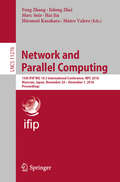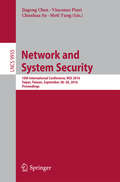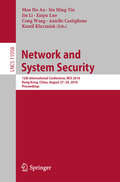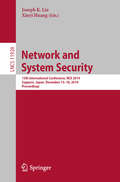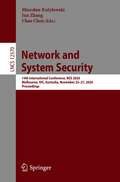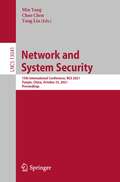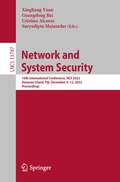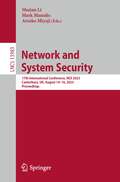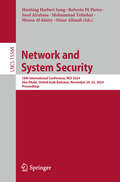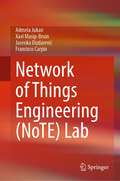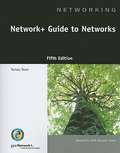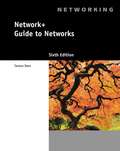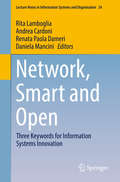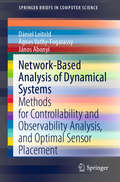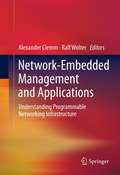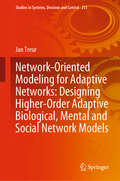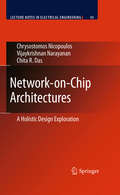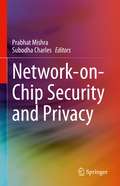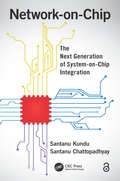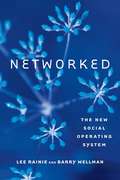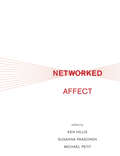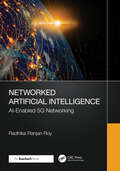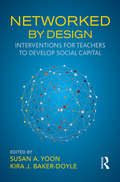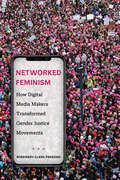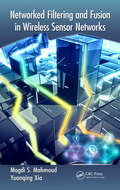- Table View
- List View
Network and Parallel Computing: IFIP International Conference, NPC 2007, Dalian, China, September 18-21, 2007, Proceedings (Lecture Notes in Computer Science #4672)
by Marc Snir Hironori Kasahara Feng Zhang Hai Jin Jidong Zhai Mateo ValeroThis book constitutes the proceedings of the 15th IFIP International Conference on Network and Parallel Computing, NPC 2018, held in Muroran, Japan, in November/December 2018. <P><P>The 22 full and 12 short papers presented in this volume were carefully reviewed and selected from 72 submissions. The papers cover traditional areas of network and parallel computing, including parallel applications, distributed algorithms, parallel architectures, software environments, and distributed tools.
Network and System Security
by Vincenzo Piuri Moti Yung Jiageng Chen Chunhua SuThis book constitutes the proceedings of the 9th International Conference on Network and System Security, NSS 2015, held in New York City, NY, USA, in November 2015. The 23 full papers and 18 short papers presented were carefully reviewed and selected from 110 submissions. The papers are organized in topical sections on wireless security and privacy; smartphone security; systems security; applications security; security management; applied cryptography; cryptosystems; cryptographic mechanisms; security mechanisms; mobile and cloud security; applications and network security.
Network and System Security: 12th International Conference, Nss 2018, Hong Kong, China, August 27-29, 2018, Proceedings (Lecture Notes in Computer Science #11058)
by Jin Li Cong Wang Aniello Castiglione Man Ho Au Siu Ming Yiu Xiapu Luo Kamil KluczniakThis book constitutes the proceedings of the 12th International Conference on Network and System Security, NSS 2018, held in Hong Kong, China, in August 2018. The 26 revised full papers and 9 short papers presented in this book were carefully reviewed and selected from 88 initial submissions. The papers cover a wide range of topics in the field, including blockchain, mobile security, applied cryptography, authentication, biometrics, IoT, privacy, and education.
Network and System Security: 13th International Conference, NSS 2019, Sapporo, Japan, December 15–18, 2019, Proceedings (Lecture Notes in Computer Science #11928)
by Xinyi Huang Joseph K. LiuThis book constitutes the proceedings of the 13th International Conference on Network and System Security, NSS 2019, held in Sapporo, Japan, in December 2019. The 36 full papers and 7 short papers presented together with 4 invited papers in this book were carefully reviewed and selected from 89 initial submissions. The papers cover a wide range of topics in the field, including authentication, access control, availability, integrity, privacy, confidentiality, dependability and sustainability of computer networks and systems.
Network and System Security: 14th International Conference, NSS 2020, Melbourne, VIC, Australia, November 25–27, 2020, Proceedings (Lecture Notes in Computer Science #12570)
by Jun Zhang Chao Chen Mirosław KutyłowskiThis book constitutes the refereed proceedings of the 14th International Conference on Network and System Security, NSS 2020, held in Melbourne, VIC, Australia, in November 2020. The 17 full and 9 short papers were carefully reviewed and selected from 60 submissions. The selected papers are devoted to topics such as secure operating system architectures, applications programming and security testing, intrusion and attack detection, cybersecurity intelligence, access control, cryptographic techniques, cryptocurrencies, ransomware, anonymity, trust, recommendation systems, as well machine learning problems.Due to the Corona pandemic the event was held virtually.
Network and System Security: 15th International Conference, NSS 2021, Tianjin, China, October 23, 2021, Proceedings (Lecture Notes in Computer Science #13041)
by Yang Liu Min Yang Chao ChenThis book constitutes the refereed proceedings of the 15th International Conference on Network and System Security, NSS 2021, held in Tianjin, China, on October 23, 2021. The 16 full and 8 short papers presented in this book were carefully reviewed and selected from 62 submissions. They focus on theoretical and practical aspects of network and system security, such as authentication, access control, availability, integrity, privacy, confidentiality, dependability and sustainability of computer networks and systems.
Network and System Security: 16th International Conference, NSS 2022, Denarau Island, Fiji, December 9–12, 2022, Proceedings (Lecture Notes in Computer Science #13787)
by Cristina Alcaraz Suryadipta Majumdar Xingliang Yuan Guangdong BaiThis book constitutes the refereed proceedings of the 16th International Conference on Network and System Security, NSS 2022, held in Denarau Island, Fiji, on December 9-12, 2022.The 23 full and 18 short papers presented in this book were carefully reviewed and selected from 83 submissions. They focus on theoretical and practical aspects of network and system security, such as authentication, access control, availability, integrity, privacy, confidentiality, dependability and sustainability of computer networks and systems.
Network and System Security: 17th International Conference, NSS 2023, Canterbury, UK, August 14–16, 2023, Proceedings (Lecture Notes in Computer Science #13983)
by Shujun Li Atsuko Miyaji Mark ManulisThis book constitutes the refereed proceedings of the 17th International Conference on Network and System Security, NSS 2023, held in Canterbury, UK, August 14–16, 2023.The 12 full and 9 short papers presented together with 2 invited talks in this book were carefully reviewed and selected from 64 submissions. They focus on Attacks and Malware, Blockchain, Security through Hardware, Machine learning and much more.
Network and System Security: 18th International Conference, NSS 2024, Abu Dhabi, United Arab Emirates, November 20–22, 2024, Proceedings (Lecture Notes in Computer Science #15564)
by Saed Alrabaee Roberto Di Pietro Houbing Herbert Song Mohammad Tubishat Mousa Al-Kfairy Omar AlfandiThis book constitutes the refereed proceedings of the 18th International Conference on Network and System Security, NSS 2024, held in Abu Dhabi, United Arab Emirates, during November 20–22, 2024. The 21 full papers presented in this book were carefully reviewed and selected from 62 submissions. They are grouped into these topical sections: authentication and security; privacy and encryption; malware detection and prevention; system security and prevention; network and infrastructure security; blockchain and smart contracts; and data security.
Network of Things Engineering (NoTE) Lab
by Admela Jukan Xavi Masip-Bruin Jasenka Dizdarević Francisco CarpioThis book provides a hands-on experience in software and hardware engineering of IoT devices in edge and cloud computing systems, by putting in practice state-of-the-art concepts of hardware devices, networking and computing software. It proposes a Network of Things Engineering (NoTE) Lab, with seven hands-on lab modules covering topics ranging from “Interfacing sensors and actuators” and “Connecting IoT and Edge with MQTT" to “Data pipelining in cloud computing”. All tools and software used in the NoTE Lab are free and open source, and available to the readers. Specifically, Arduino-based boards that support a variety of low-cost sensors and actuators are used in IoT context. In edge computing, NoTE Lab implements off-the-shelf single board computers, Raspberry Pis with corresponding software and hardware. For cloud, well-known and widely used cloud computing open-source tools (e.g., Kubernetes) are deployed, where readers can learn the basics of monitoring and managing containers in cloud computing. Three communication protocols are used in the end-to-end setup, including MQTT, AMQP and HTTP. This lab book is a "must experiment with" for anybody in academia and industry participating in the fascinating IoT-edge-cloud continuum development.
Network+ Guide to Networks (5th edition)
by Tamara DeanThis book introduces the fundamental building blocks that form a modern network, such as protocols, topologies, hardware, and network operating systems. It then provides in-depth coverage of the most important concepts in contemporary networking, such as TCP/IP, Ethernet, wireless transmission, and security.
Network+ Guide to Networks 6th Edition
by Tamara DeanThe completely updated NETWORK+ GUIDE TO NETWORKS, 6th Edition gives readers the technical skills and industry know-how required to begin an exciting career installing, configuring, and troubleshooting computer networks. The text also prepares readers for CompTIA's Network+ N10-005 certification exam with fundamentals in protocols, topologies, hardware, and network design. After exploring TCP/IP, Ethernet, wireless transmission, and security concepts, as well as an all-new chapter on virtual networks, readers can increase their knowledge with the practical "On-the Job" stories, Review Questions, Hands-On Projects, and Case Projects
Network, Smart and Open
by Daniela Mancini Renata Paola Dameri Rita Lamboglia Andrea CardoniThis book presents a collection of original research papers addressing the relationship between information systems (IS) and innovation. “Open”, “Smart” and “Network” are three keywords that are currently guiding information systems (IS) innovation, enhancing IS potentialities and their ability to support decision-making processes. The book discusses the relevance of these three new concepts in connection with technological and organizational innovations (i.e. cloud, smart technologies and networking), and the role they play in the development of accounting and management information systems.The book’s primary aim is to investigate how these innovations could influence information systems (with a particular focus on accounting and management information systems) by enhancing their information potentialities and improving accounting methodologies, performance measurement systems, data management, information systems architectures, and external and internal reporting.The book is based on a selection of the best papers—original double-blind reviewed contributions—presented at the 2016 Annual Conference of the Italian Chapter of the Association for Information Systems (AIS).
Network-Based Analysis of Dynamical Systems: Methods for Controllability and Observability Analysis, and Optimal Sensor Placement (SpringerBriefs in Computer Science)
by János Abonyi Ágnes Vathy-Fogarassy Dániel LeitoldThis book explores the key idea that the dynamical properties of complex systems can be determined by effectively calculating specific structural features using network science-based analysis. Furthermore, it argues that certain dynamical behaviours can stem from the existence of specific motifs in the network representation.Over the last decade, network science has become a widely applied methodology for the analysis of dynamical systems. Representing the system as a mathematical graph allows several network-based methods to be applied, and centrality and clustering measures to be calculated in order to characterise and describe the behaviours of dynamical systems. The applicability of the algorithms developed here is presented in the form of well-known benchmark examples. The algorithms are supported by more than 50 figures and more than 170 references; taken together, they provide a good overview of the current state of network science-based analysis of dynamical systems, and suggest further reading material for researchers and students alike. The files for the proposed toolbox can be downloaded from a corresponding website.
Network-Embedded Management and Applications
by Ralf Wolter Alexander ClemmDespite the explosion of networking services and applications in the past decades, the basic technological underpinnings of the Internet have remained largely unchanged. At its heart are special-purpose appliances that connect us to the digital world, commonly known as switches and routers. Now, however, the traditional framework is being increasingly challenged by new methods that are jostling for a position in the "next-generation" Internet. The concept of a network that is becoming more programmable is one of the aspects that are taking center stage. This opens new possibilities to embed software applications inside the network itself and to manage networks and communications services with unprecedented ease and efficiency. In this edited volume, distinguished experts take the reader on a tour of different facets of programmable network infrastructure and applications that exploit it. Presenting the state of the art in network embedded management and applications and programmable network infrastructure, the book conveys fundamental concepts and provides a glimpse into various facets of the latest technology in the field.
Network-Oriented Modeling for Adaptive Networks: Designing Higher-Order Adaptive Biological, Mental and Social Network Models (Studies in Systems, Decision and Control #251)
by Jan TreurThis book addresses the challenging topic of modeling adaptive networks, which often manifest inherently complex behavior. Networks by themselves can usually be modeled using a neat, declarative, and conceptually transparent Network-Oriented Modeling approach. In contrast, adaptive networks are networks that change their structure; for example, connections in Mental Networks usually change due to learning, while connections in Social Networks change due to various social dynamics. For adaptive networks, separate procedural specifications are often added for the adaptation process. Accordingly, modelers have to deal with a less transparent, hybrid specification, part of which is often more at a programming level than at a modeling level. This book presents an overall Network-Oriented Modeling approach that makes designing adaptive network models much easier, because the adaptation process, too, is modeled in a neat, declarative, and conceptually transparent Network-Oriented Modeling manner, like the network itself. Thanks to this approach, no procedural, algorithmic, or programming skills are needed to design complex adaptive network models. A dedicated software environment is available to run these adaptive network models from their high-level specifications. Moreover, because adaptive networks are described in a network format as well, the approach can simply be applied iteratively, so that higher-order adaptive networks in which network adaptation itself is adaptive (second-order adaptation), too can be modeled just as easily. For example, this can be applied to model metaplasticity in cognitive neuroscience, or second-order adaptation in biological and social contexts. The book illustrates the usefulness of this approach via numerous examples of complex (higher-order) adaptive network models for a wide variety of biological, mental, and social processes. The book is suitable for multidisciplinary Master’s and Ph.D. students without assuming much prior knowledge, although also some elementary mathematical analysis is involved. Given the detailed information provided, it can be used as an introduction to Network-Oriented Modeling for adaptive networks. The material is ideally suited for teaching undergraduate and graduate students with multidisciplinary backgrounds or interests. Lecturers will find additional material such as slides, assignments, and software.
Network-on-Chip Architectures
by Chita R. Das Vijaykrishnan Narayanan Chrysostomos NicopoulosThe continuing reduction of feature sizes into the nanoscale regime has led to dramatic increases in transistor densities. Integration at these levels has highlighted the criticality of the on-chip interconnects. Network-on-Chip (NoC) architectures are viewed as a possible solution to burgeoning global wiring delays in many-core chips, and have recently crystallized into a significant research domain. On-chip networks instill a new flavor to communication research due to their inherently resource-constrained nature. Despite the lightweight character demanded of the NoC components, modern designs require ultra-low communication latencies in order to cope with inflating data bandwidths. The work presented in Network-on-Chip Architectures addresses these issues through a comprehensive exploration of the design space. The design aspects of the NoC are viewed through a penta-faceted prism encompassing five major issues: (1) performance, (2) silicon area consumption, (3) power/energy efficiency, (4) reliability, and (5) variability. These five aspects serve as the fundamental design drivers and critical evaluation metrics in the quest for efficient NoC implementations. The research exploration employs a two-pronged approach: (a) MICRO-architectural innovations within the major NoC components, and (b) MACRO-architectural choices aiming to seamlessly merge the interconnection backbone with the remaining system modules. These two research threads and the aforementioned five key metrics mount a holistic and in-depth attack on most issues surrounding the design of NoCs in multi-core architectures.
Network-on-Chip Security and Privacy
by Prabhat Mishra Subodha CharlesThis book provides comprehensive coverage of Network-on-Chip (NoC) security vulnerabilities and state-of-the-art countermeasures, with contributions from System-on-Chip (SoC) designers, academic researchers and hardware security experts. Readers will gain a clear understanding of the existing security solutions for on-chip communication architectures and how they can be utilized effectively to design secure and trustworthy systems.
Network-on-Chip: The Next Generation of System-on-Chip Integration
by Santanu Kundu Santanu ChattopadhyayAddresses the Challenges Associated with System-on-Chip Integration Network-on-Chip: The Next Generation of System-on-Chip Integration examines the current issues restricting chip-on-chip communication efficiency, and explores Network-on-chip (NoC), a promising alternative that equips designers with the capability to produce a scalable, reusable, and high-performance communication backbone by allowing for the integration of a large number of cores on a single system-on-chip (SoC). This book provides a basic overview of topics associated with NoC-based design: communication infrastructure design, communication methodology, evaluation framework, and mapping of applications onto NoC. It details the design and evaluation of different proposed NoC structures, low-power techniques, signal integrity and reliability issues, application mapping, testing, and future trends. Utilizing examples of chips that have been implemented in industry and academia, this text presents the full architectural design of components verified through implementation in industrial CAD tools. It describes NoC research and developments, incorporates theoretical proofs strengthening the analysis procedures, and includes algorithms used in NoC design and synthesis. In addition, it considers other upcoming NoC issues, such as low-power NoC design, signal integrity issues, NoC testing, reconfiguration, synthesis, and 3-D NoC design. This text comprises 12 chapters and covers: The evolution of NoC from SoC—its research and developmental challenges NoC protocols, elaborating flow control, available network topologies, routing mechanisms, fault tolerance, quality-of-service support, and the design of network interfaces The router design strategies followed in NoCs The evaluation mechanism of NoC architectures The application mapping strategies followed in NoCs Low-power design techniques specifically followed in NoCs The signal integrity and reliability issues of NoC The details of NoC testing strategies reported so far The problem of synthesizing application-specific NoCs Reconfigurable NoC design issues Direction of future research and development in the field of NoC Network-on-Chip: The Next Generation of System-on-Chip Integration covers the basic topics, technology, and future trends relevant to NoC-based design, and can be used by engineers, students, and researchers and other industry professionals interested in computer architecture, embedded systems, and parallel/distributed systems.
Networked
by Lee Rainie Barry WellmanDaily life is connected life, its rhythms driven by endless email pings and responses, the chimes and beeps of continually arriving text messages, tweets and retweets, Facebook updates, pictures and videos to post and discuss. Our perpetual connectedness gives us endless opportunities to be part of the give-and-take of networking. Some worry that this new environment makes us isolated and lonely. But in Networked, Lee Rainie and Barry Wellman show how the large, loosely knit social circles of networked individuals expand opportunities for learning, problem solving, decision making, and personal interaction. The new social operating system of "networked individualism" liberates us from the restrictions of tightly knit groups; it also requires us to develop networking skills and strategies, work on maintaining ties, and balance multiple overlapping networks. Rainie and Wellman outline the "triple revolution" that has brought on this transformation: the rise of social networking, the capacity of the Internet to empower individuals, and the always-on connectivity of mobile devices. Drawing on extensive evidence, they examine how the move to networked individualism has expanded personal relationships beyond households and neighborhoods; transformed work into less hierarchical, more team-driven enterprises; encouraged individuals to create and share content; and changed the way people obtain information. Rainie and Wellman guide us through the challenges and opportunities of living in the evolving world of networked individuals.
Networked Affect
by Ken Hillis Michael Petit Susanna PaasonenInvestigations of affective experiences that emerge in online settings that range from Facebook discussion forums to “smart” classrooms.Our encounters with websites, avatars, videos, mobile apps, discussion forums, GIFs, and nonhuman intelligent agents allow us to experience sensations of connectivity, interest, desire, and attachment—as well as detachment, boredom, fear, and shame. Some affective online encounters may arouse complex, contradictory feelings that resist dualistic distinctions. In this book, leading scholars examine the fluctuating and altering dynamics of affect that give shape to online connections and disconnections. Doing so, they tie issues of circulation and connectivity to theorizations of networked affect. Their diverse investigations—considering subjects that range from online sexual dynamics to the liveliness of computer code—demonstrate the value of affect theories for Internet studies. The contributors investigate networked affect in terms of intensity, sensation, and value. They explore online intensities that range from Tumblr practices in LGBTQ communities to visceral reactions to animated avatars; examine the affective materiality of software in such platforms as steampunk culture and nonprofit altporn; and analyze the ascription of value to online activities including the GTD (“getting things done”) movement and the accumulation of personal digital materials. ContributorsJames Ash, Alex Cho, Jodi Dean, Melissa Gregg, Ken Hillis, Kylie Jarrett, Tero Karppi, Stephen Maddison, Susanna Paasonen, Jussi Parikka, Michael Petit, Jennifer Pybus, Jenny Sundén, Veronika Tzankova
Networked Artificial Intelligence: AI-Enabled 5G Networking
by Radhika Ranjan RoyThe integration of fifth generation (5G) wireless technologies with distributed artificial intelligence (AI) is transforming network operations. AI is increasingly embedded in all network elements, from cloud and edge to terminal devices, enabling AI to function as a networking system. This convergence facilitates AI-based applications across the global network, with notable successes in various domains such as computer vision, natural language processing, and healthcare. Networked Artificial Intelligence: AI-Enabled 5G Networking a comprehensive framework for the deep integration of computing and communications, optimizing networks and applications as a unified system using AI.The book covers topics ranging from networked AI fundamentals to AI-enabled 5G networks, including agent modeling, machine learning (ML) algorithms, and network protocol architectures. It discusses how network service providers can leverage AI and ML techniques to customize network baselines, reduce noise, and accurately identify issues. It also looks at AI-driven networks that enable self-correction for maximum uptime and prescriptive actions for issue resolution, as well as troubleshooting by capturing and storing data before network events.The book presents a comprehensive approach to AI-enabled networking that offers unprecedented opportunities for efficiency, reliability, and innovation in telecommunications. It works through the approach’s five steps of connection, communication, collaboration, curation, and community. These steps enhance network effects, empowering operators with insights for trusted automation, cost reduction, and optimal user experiences. The book also discusses AI and ML capabilities that enable networks to continuously learn, self-optimize, and predict and rectify service degradations proactively, even with full automation.
Networked By Design: Interventions for Teachers to Develop Social Capital
by Susan A. Yoon Kira J. Baker-DoyleNetworked by Design brings together work from leading international scholars in the learning sciences that applies social network theory to teachers’ social interactions and relationships. The volume examines the direct and indirect relationships and communities that teachers navigate, as well as the models, plans, and other interventions that allow them to exercise control over these networks. Each chapter draws from case studies or latitudinal research to investigate a different intervention and its outcomes. By presenting research conducted in a variety of scales and contexts, this book offers scholars, future teachers, and leaders diverse insights into how interventions in social capital and social networks can create impactful, meaningful teaching and learning.
Networked Feminism: How Digital Media Makers Transformed Gender Justice Movements
by Rosemary Clark-ParsonsNetworked Feminism tells the story of how activists have used media to reconfigure what feminist politics and organizing look like in the United States. Drawing on years spent participating in grassroots communities and observing viral campaigns, Rosemary Clark-Parsons argues that feminists engage in a do-it-ourselves feminism characterized by the use of everyday media technologies. Faced with an electoral system and a history of collective organizing that have failed to address complex systems of oppression, do-it-ourselves feminists do not rely on political organizations, institutions, or authorities. Instead, they use digital networks to build movements that reflect their values and meet the challenges of the current moment, all the while juggling the advantages and limitations of their media tools. Through its practitioner-centered approach, this book sheds light on feminist media activists' shared struggles and best practices at a time when collective organizing for social justice has become more important than ever.
Networked Filtering and Fusion in Wireless Sensor Networks
by Magdi S. Mahmoud Yuanqing XiaBy exploiting the synergies among available data, information fusion can reduce data traffic, filter noisy measurements, and make predictions and inferences about a monitored entity. Networked Filtering and Fusion in Wireless Sensor Networks introduces the subject of multi-sensor fusion as the method of choice for implementing distributed systems.T
